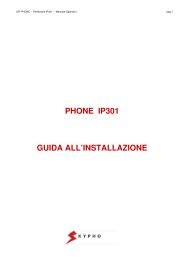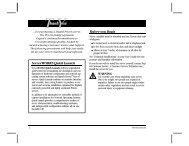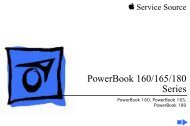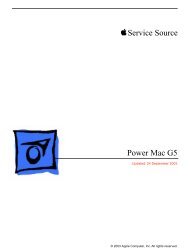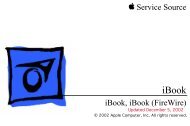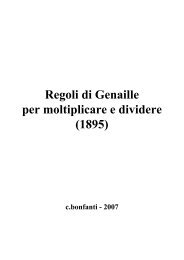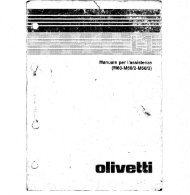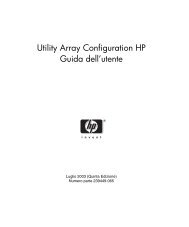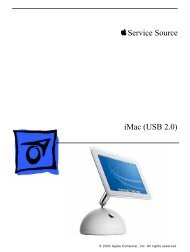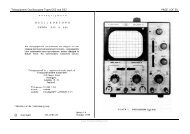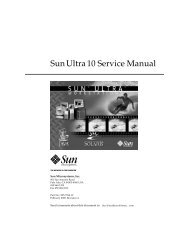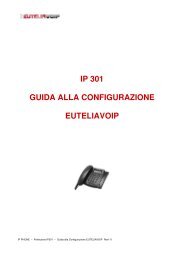HPJournal1989Jun_798.. - Dynamic Softer for Background-Images
HPJournal1989Jun_798.. - Dynamic Softer for Background-Images
HPJournal1989Jun_798.. - Dynamic Softer for Background-Images
You also want an ePaper? Increase the reach of your titles
YUMPU automatically turns print PDFs into web optimized ePapers that Google loves.
matched. The following lines of code are an algorithmic<br />
representation of these steps:<br />
currenlbyte-sequence :: GET-INPUT-BYTE;<br />
REPEAT<br />
REPEAT<br />
matched<br />
is searched <strong>for</strong> NT. Since this is not found, a dictionary<br />
entry <strong>for</strong> NT is built and the codeword <strong>for</strong> N is output. The<br />
same sequence occurs <strong>for</strong> the characters T and I. A<br />
codeword <strong>for</strong> T is output and a dictionary entry is built<br />
<strong>for</strong> TL<br />
Up to this point, no compression has occurred, since<br />
there have been no multiple character matches. In actuality,<br />
the output stream has expanded slightly, since four B-bit<br />
:: SEARCH DICTIONARY(currenlbyte-sequence,<br />
returned codeword);<br />
lF (matched: TRUE) THEN<br />
BEGIN<br />
longeslbyte-sequence :: currenLbyte-sequence;<br />
longeslcodeword :- returned-codeword;<br />
currenlbyte sequence : = currenlbyte-sequence +<br />
GET_INPUT_BYTE;<br />
END;<br />
UNTIL (matched: FALSE);<br />
BU I LD-DICTIONARY(cunenLbyte-sequence) ;<br />
OUTPUT-CODEWORD(longeslcodeword) ;<br />
currenLbyte-sequence :: currenl byte-sequence -<br />
longeslbyte-seque nce ;<br />
UNTIL (no more input bytes to compress);<br />
In this example, the compression algorithm begins after<br />
the first R has been accepted by the compression engine.<br />
The input character R matches the character R that was<br />
placed in the dictionary during its initialization' Since<br />
there was a match, the engine accepts another byte, this<br />
one being the character I. The sequence RI is now searched<br />
<strong>for</strong> in the dictionary but no match is found. Consequently,<br />
a new dictionary entry RI is built and the codeword <strong>for</strong><br />
the largest matching sequence (i.e., the codeword <strong>for</strong> the<br />
character R) is output. The engine now searches <strong>for</strong> I in<br />
the dictionary and finds a match iust as it did with R.<br />
Another character is input (N) and a search begins <strong>for</strong> the<br />
sequence IN. Since IN does not match any entries, a new<br />
one is built and the codeword <strong>for</strong> the largest matching<br />
sequence (i.e., the codeword <strong>for</strong> the character I) is output.<br />
This process continues with a search <strong>for</strong> the letter N. After<br />
N is found, the next character is input and the dictionary<br />
characters have been replaced by four 9-bit codewords.<br />
(That represents a 32-bit to 36-bit expansion, or a 1.125:1<br />
expansion ratio,) However, after the next character has been<br />
input, compression of the data begins. At this point, the<br />
engine is searching <strong>for</strong> the IN sequence. Since it finds a<br />
match, it accepts another character and begins searching<br />
<strong>for</strong> INT. When it doesn't find a match, it builds a dictionary<br />
entry <strong>for</strong> INT and outputs the previously generated<br />
codeword <strong>for</strong> the sequence IN. Two B-bit characters have<br />
now been replaced by one 9-bit codeword <strong>for</strong> a compression<br />
ralio of 16/9 or 1,.778:1 .<br />
This process continues and again two characters are replaced<br />
with a single codeword. The engine begins with a<br />
T from the previous sequence and then accepts the next<br />
character which is an I. It searches <strong>for</strong> the TI sequence and<br />
finds a match, so another byte is input. Now the chip is<br />
searching <strong>for</strong> the TIN sequence. No match is found, so a<br />
TIN entry is built and the codeword <strong>for</strong> TI is output. This<br />
sequence also exhibits the 1..778:L compression ratio that<br />
the IN sequence exhibited. The net compression ratio <strong>for</strong><br />
this string of 9 bytes is 1.L43:1. This is not a particularly<br />
Iarge compression ratio because the example consists of a<br />
very small number of bytes. With a larger sample of data,<br />
more sequences of data are stored and larger sequences of<br />
bytes are replaced by a single codeword. It is possible to<br />
achieve compression ratios that range from 1:1 up to 110:1'<br />
The per<strong>for</strong>mance section of this article presents measured<br />
compression ratios <strong>for</strong> various computer systems and data<br />
types.<br />
A simplified diagram of the decompression process implemented<br />
in the HP-DC IC is shown in Fig. 3. This example<br />
uses the output of the previous compression example as<br />
input. The decompression process looks very similar to<br />
lnpul<br />
Codeword<br />
Stream<br />
Look Up<br />
Associated<br />
Characters<br />
Build<br />
Dictionary<br />
Entry<br />
Output<br />
Byte<br />
Stream<br />
Fig. 3. Decompression algotithm<br />
example<br />
28 rewrerr-pncr,qRD JoURNAL JUNE 1989




